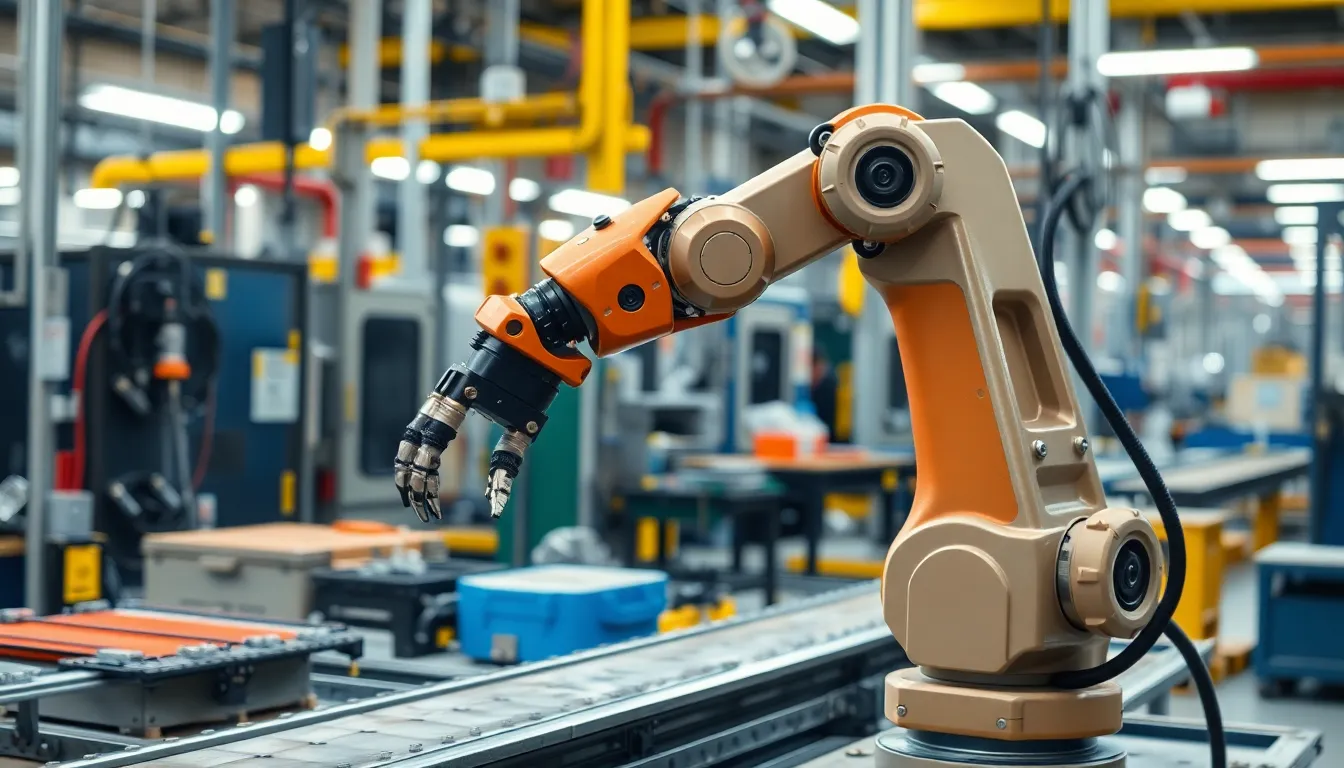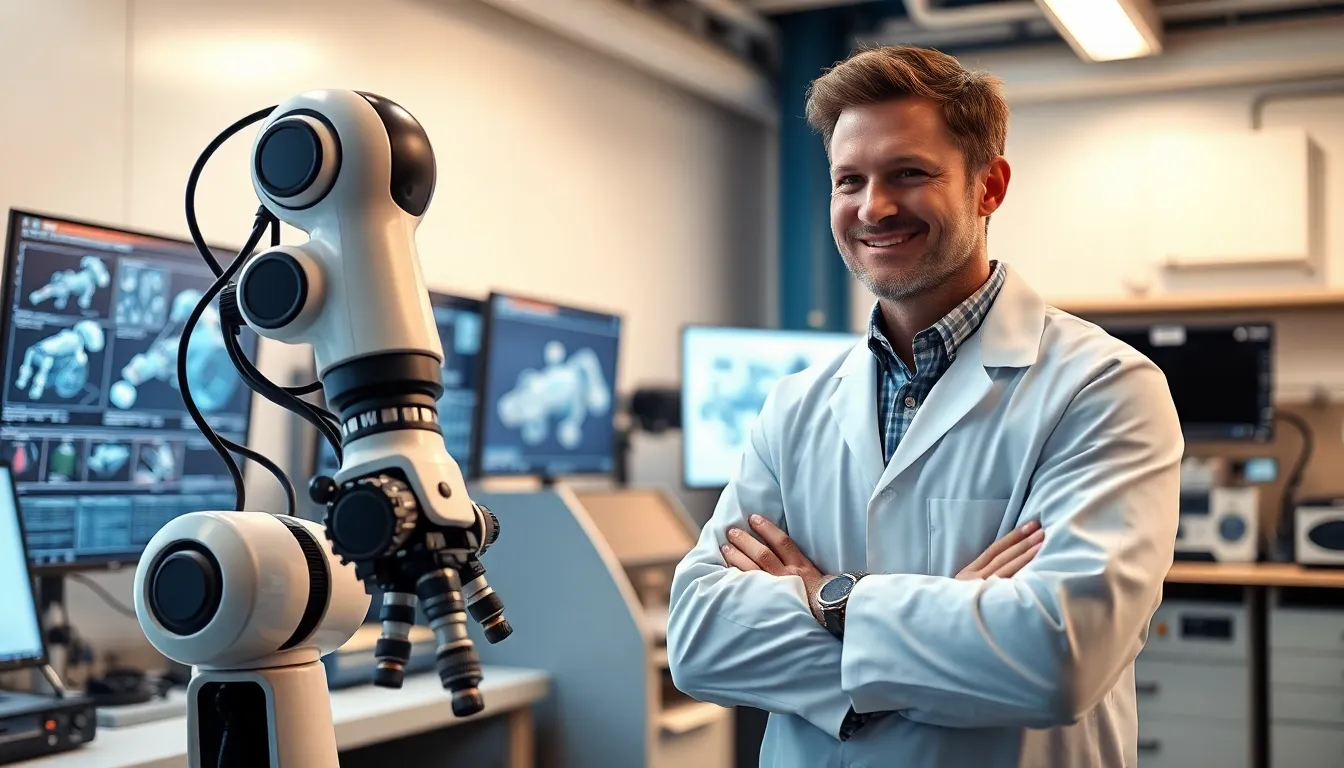Robotics isn’t just for sci-fi movies anymore; it’s a thrilling reality that’s reshaping our world. Imagine a future where robots don’t just vacuum your living room but also help in surgeries, explore distant planets, or even whip up your favorite meal. It sounds like a plot twist from a Hollywood blockbuster, but it’s happening right now, and it’s more exciting than a cat video going viral.
As technology leaps forward, robotics is becoming an integral part of everyday life. From manufacturing to healthcare, these mechanical marvels are revolutionizing industries and making tasks more efficient. So buckle up and get ready to explore the fascinating world of robotics, where innovation meets imagination and a little bit of humor. After all, who wouldn’t want a robot sidekick that can do more than just hold a door open?
Table of Contents
ToggleOverview of Robotics
Robotics encompasses the design, construction, operation, and use of robots. These machines are engineered to perform tasks traditionally requiring human intelligence or effort. In various fields, such as manufacturing, robots enhance efficiency and precision.
Healthcare benefits significantly from robotics, as surgical robots assist in complex procedures. These systems improve outcomes by increasing accuracy and minimizing recovery times. Additionally, robotic exoskeletons support rehabilitation in patients with mobility difficulties.
Space exploration also heavily relies on robotics. Rovers, like NASA’s Perseverance, gather data from distant planets, providing insights impossible to obtain directly. Such technology broadens human understanding of extreme environments.
Industry uses automation, powered by robotics, to streamline operations and reduce costs. Manufacturing robots play critical roles on assembly lines, bolstering productivity while ensuring safety. Collaboration between robots and humans in workspace settings is on the rise, promoting efficiency.
Educational institutions integrate robotics into curricula, fostering interest in STEM fields. Students engage with programming and robotics, preparing for future careers. The growing accessibility of robotics kits makes learning opportunities even broader.
Innovations in artificial intelligence further enhance robotic capabilities. Machines can now adapt to dynamic environments, allowing for more complex tasks. As technology progresses, the integration of robotics into daily life continues to expand.
Robots are not just tools; they represent a shift in how society interacts with technology. Ongoing advancements hint at transformative changes ahead, presenting exciting possibilities for the future across multiple sectors.
Applications of Robotics

Robotics plays a crucial role across various sectors, transforming operations and enhancing efficiency. Multiple applications demonstrate the diverse capabilities of robotics.
Industrial Robotics
Industrial robotics significantly boosts manufacturing productivity. Robots handle repetitive tasks with precision, freeing human workers for more complex activities. These machines can operate 24/7, reducing production times and increasing output. Companies report decreased labor costs and improved safety due to automation. Examples include robotic arms utilized for assembly, welding, and packaging. Numerous industries, including automotive and electronics, rely on these advanced technologies to maintain competitiveness and efficiency.
Service Robotics
Service robotics enhances everyday experiences in various domains. Robots assist with tasks ranging from delivery to customer interaction. Autonomous vacuum cleaners and lawn care robots improve household management, while retail robots guide shoppers to products. These technologies streamline services in restaurants and hotels by taking orders and facilitating check-ins. Their integration aids businesses in meeting customer demands while minimizing labor shortages. Many consumers find interactions with service robots enjoyable, adding novelty to their encounters.
Medical Robotics
Medical robotics revolutionizes healthcare delivery and patient care. Surgical robots enable surgeons to perform minimally invasive procedures with exceptional accuracy. Technologies like robotic exoskeletons support patient rehabilitation and mobility. Hospitals incorporate robotic systems for tasks such as medication delivery and disinfection. Studies indicate improved recovery times and patient outcomes when utilizing robotic assistance. Their deployment not only enhances efficiency but also elevates the standard of care provided in medical settings.
The Technology Behind Robotics
Robotics technology integrates several advanced systems that enhance functionality and intelligence. Key components include artificial intelligence, sensors, and actuators.
Artificial Intelligence in Robotics
Artificial intelligence drives intelligent decision-making in robots. AI algorithms enable machines to learn from experiences and adapt quickly to new challenges. Machine learning enhances recognition capabilities, allowing robots to interpret visual data accurately. Natural language processing lets robots understand and respond to human commands effectively. Innovations in AI empower robots to operate in unpredictable environments, leading to increased autonomy and efficiency.
Sensors and Actuators
Sensors play a crucial role in how robots perceive surroundings. These devices detect light, temperature, motion, and obstacles, providing essential data for navigation and interaction. Actuators serve as the muscles of robots, converting electrical energy into physical motion. Types of actuators include motors and hydraulic systems, enabling precise movements. Together, sensors and actuators create a responsive system that enhances a robot’s ability to perform tasks reliably in various applications.
Future Trends in Robotics
Advancements in robotics point toward a future rich with potential and innovation. Collaborative robots, also known as cobots, appear increasingly in workplaces, assisting human workers rather than replacing them. These robots enhance efficiency through safe interaction and task sharing, promoting productivity in various environments.
AI integration continues to expand, enabling robots to process vast amounts of data and make informed decisions. Machine learning allows them to adapt to new situations and optimize performance over time. This evolution ensures robotic systems remain relevant as industries change and demands increase.
Healthcare robotics stand poised for significant development. Surgical robots, enhanced by AI and advanced imaging, promise greater precision in minimally invasive procedures. Robotic rehabilitation devices leverage AI to tailor recovery plans, fostering better patient outcomes and improving overall healthcare delivery.
Explore the rise of autonomous vehicles, including drones and delivery robots, which revolutionize transport and logistics. Companies like Amazon and Google invest heavily in this area, signaling a shift in how goods are delivered. Consumer acceptance grows as these technologies prove reliable and efficient.
Another trend focuses on social robotics, designed to interact with humans in meaningful ways. Companion robots assist the elderly or support mental wellness, offering companionship and emotional interaction. These applications underscore the integration of robotics into daily life.
Sustainability efforts increasingly drive robotics development. Robots streamline processes in recycling, waste management, and agriculture, optimizing resource use and reducing environmental impact. The push toward sustainable practices encourages engineers and researchers to innovate in eco-friendly robotics.
Innovations in materials science lead to lighter, more durable robotic structures. Advances in soft robotics contribute to safer interactions in healthcare and service industries. Novel materials enhance the functionality and versatility of robots across various applications.
Ethical Considerations in Robotics
Robotics raises significant ethical questions about design and implementation. Safety concerns dominate discussions on how robots interact with humans and environments. Developers must prioritize safety measures to prevent accidents and ensure reliability in critical applications like healthcare and autonomous vehicles.
Privacy issues also arise due to data collection by robots. Surveillance robots, for instance, can inadvertently infringe on individuals’ privacy rights. Designers must establish clear guidelines for data usage and storage to protect personal information and ensure transparency.
Accountability in robot behavior poses another ethical challenge. When robots malfunction or cause harm, the question of responsibility becomes complex. Stakeholders, including manufacturers and programmers, should exhibit clear accountability frameworks to address issues arising from robotic actions.
Bias in algorithms adds a layer of ethical complexity in robotics. AI-driven robots can perpetuate societal biases present in training data. Researchers must actively work to identify and mitigate these biases, ensuring robots serve diverse populations fairly.
Job displacement concerns emerge as automation advances. Robots are set to take over specific tasks, leading to workforce displacement in certain sectors. Employers should implement retraining programs to assist workers in transitioning to new roles created by robotic advancements.
Environmental impacts also need consideration. Robotics can optimize processes, as seen in recycling and agriculture practices. Striking a balance between innovation and environmental sustainability ensures that robotics contribute positively to ecological goals.
Regulatory frameworks are essential for governing robotic technologies. Policymakers must collaborate with technologists to create comprehensive regulations that address safety, privacy, and ethical use. Continued dialogue will help shape an ethical approach to robotics in society.
Robotics is reshaping the landscape of everyday life and various industries. As technology continues to evolve the potential for robots to assist in complex tasks becomes increasingly evident. From enhancing surgical precision in healthcare to revolutionizing logistics with autonomous vehicles the impact is profound.
The integration of artificial intelligence and advanced sensors is driving innovation and creating opportunities for collaboration between humans and machines. While ethical considerations and safety remain crucial discussions the future holds exciting possibilities.
As society embraces these advancements the role of robotics will only expand. This transformation invites everyone to imagine a world where robots are essential partners in progress and innovation.




